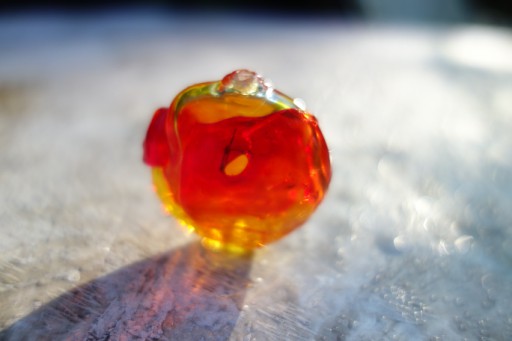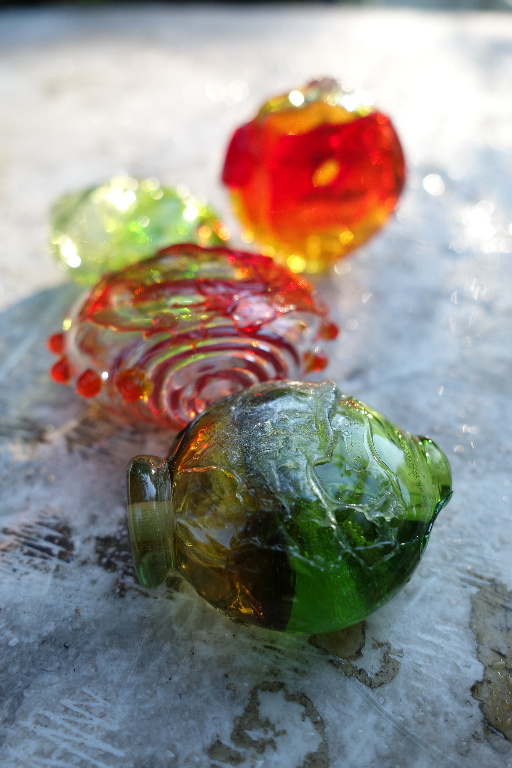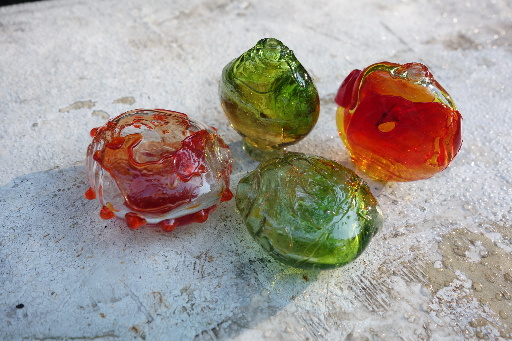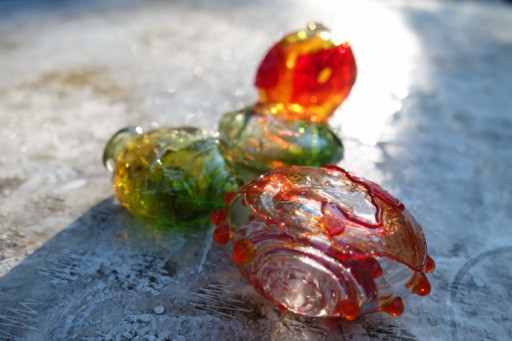So one of the things I've been doing recently to tidy up the studio is use up various shards, stringer bits, etc. What some famous beadmaker whose name I can't recall did with her ‘end of the day bead’, except in my case, it's more like end of the month or quarter. —The red shards were probably blown by Frances, who blew them nice and thick.
This led to a nice effect: the changing thickness of the glass shard served to create gradations, as did the interactions between the yellow base glass and the red shard.

pressed hollow lentil. Manufactured 14sep, photographed 17sep2015 around 9am. Sony ‘cybershot’ RX100, f1.8, 1/500sec +1.0EV, AWB[1] .
And then we have the violet blue cast of the light on the table's rear left edge, as well as the turquoise cast to the shadows in the right foreground, an artifact of the camera's attempt to balance the light, which really helps to pop that orange even more. Not to mention all the dew and fun bokeh. This is not actually that great of a bead, shape-wize: it was too small to fill the press. I mean, that top hole (fortunately somewhat out of focus) is pretty bad. Moreover, the shard came from the base of bubble, meaning there was an extremely thick, ungainly portion where it attached to the blowpipe (on the bead's left shoulder. —The hole in the middle of the shard was not there originally, but because the shard didn't attach to the base bead there, that section melted away, thickening the edge and framing a serendipitous accent.[2] Since however the bead is intended to be part of a red bead curtain for Frances, these various flaws don't so much matter.

2nd setup, showing all the beads. I love the way the orange light reflects on the foreground bead. 1/80sec, f4, +0.3EV
In fact all of these beads were intended for bead curtains—mine or Frances; and they all show poor technique. The reason that green lentil tends to be towards the back of these groupings is because one hole is an honest-to-goodness stringcutter.
Here the orange light is popping off the rear green bead. Glass has a reputation of being notoriously difficult to photograph well, because its reflective surfaces bounce light off everything. But sometimes, that same quality allows for very fun effects.
I wasn't using particularly sophisticated techniques or equipment—natural light and a (admittedly high-end) P&S. What was interesting to me was until I actually checked the image management program, I hadn't realized how much I had been adjusting the DOF (aperture) and EV (exposure compensation) settings—it's automatic, nearly down to muscle memory.

Here's a fairly conventional shot. f5.6, 1/30sec, +2/3EV You can see the beads pretty well, but the photography's boring.[3]
I really like these pictures, but I was mostly taking advantage of dew, morning light, the good bits[4] and, to be sure, the fact that the camera has good bokeh (something, like its macro capabilities, that I selected for.) Much of my studio photography is still bad. But really truly, technique does trump tools.
Unless otherwise noted, text, image and objects depicted therein copyright 1996--present sylvus tarn.
Sylvus Tarn